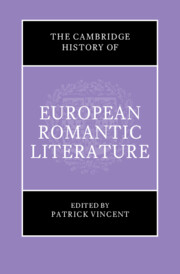Book contents
- The Cambridge History of European Romantic Literature
- The Cambridge History of European Romantic Literature
- Copyright page
- Contents
- Contributors
- Acknowledgements
- Note on the Text
- Chronology
- Introduction
- Part I Romantic Genealogies (1750–1790)
- Part II Revolution to Restoration (1790–1815)
- 7 Transcendental Revolutions
- 8 Citizens of the World
- 9 Romantic Loss, Emigration, and Exile
- 10 Women Writers’ Networks
- 11 Romantic Nationalisms
- 12 Shakespeare and Romantic Drama
- 13 Classics and Romantics
- Part III Restoration to Revolution (1815–1850)
- Further Reading
- Index
12 - Shakespeare and Romantic Drama
from Part II - Revolution to Restoration (1790–1815)
Published online by Cambridge University Press: 10 January 2024
- The Cambridge History of European Romantic Literature
- The Cambridge History of European Romantic Literature
- Copyright page
- Contents
- Contributors
- Acknowledgements
- Note on the Text
- Chronology
- Introduction
- Part I Romantic Genealogies (1750–1790)
- Part II Revolution to Restoration (1790–1815)
- 7 Transcendental Revolutions
- 8 Citizens of the World
- 9 Romantic Loss, Emigration, and Exile
- 10 Women Writers’ Networks
- 11 Romantic Nationalisms
- 12 Shakespeare and Romantic Drama
- 13 Classics and Romantics
- Part III Restoration to Revolution (1815–1850)
- Further Reading
- Index
Summary
Chapter Twelve addresses the circulation and reception of Shakespeare’s plays in the late eighteenth- and early-nineteenth century, showing how the non-classical elements of his drama vitally contributed to Romantic-period literature and culture. Beginning with a comparison of commemorations of the Bard’s bicentenary in various European capitals, the chapter then looks at his early reception in Germany and France. While Voltaire, Goethe, and Herder celebrated him as a natural genius, French critics realigned Shakespeare’s plays according to neoclassical rules. French audiences increasingly sought out melodrama, however, and accepted these ‘irregularities’, which also inspired Beaumarchais’s Figaro plays. The chapter demonstrates the productive convergences between Shakespearean drama and melodrama, pantomime, harlequinades and other popular theatrical forms, in particular as political satire. It then looks at how Tieck and A.W. Schlegel promoted Shakespeare as the supreme playwright and as part of the German opposition to Napoleon, leading to the banning of his plays in Vienna and elsewhere, and to many literary appropriations in Kleist, Goethe, and Schiller. The chapter concludes with a survey of some of Shakespeare’s influences on drama in Italy, Spain, and, again, France.
- Type
- Chapter
- Information
- The Cambridge History of European Romantic Literature , pp. 375 - 400Publisher: Cambridge University PressPrint publication year: 2023



